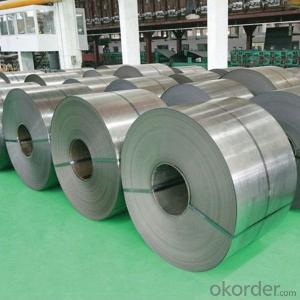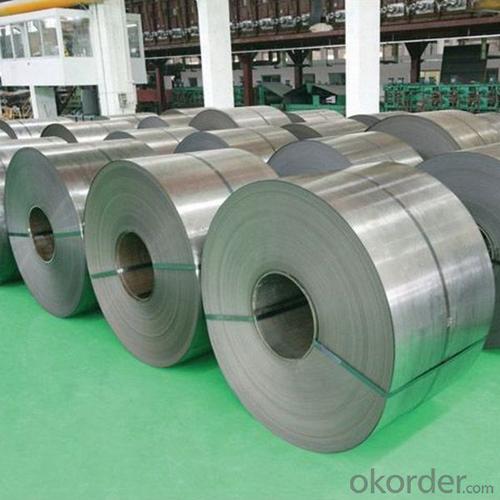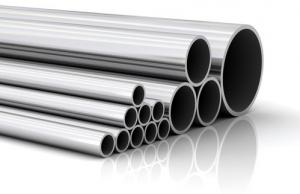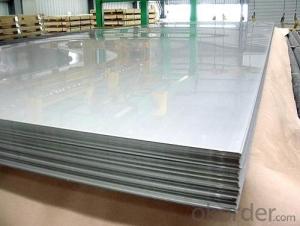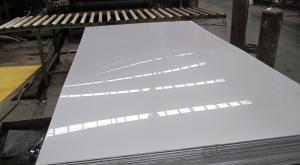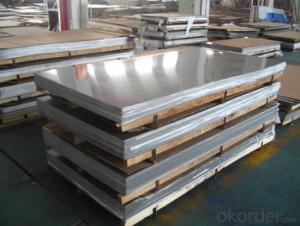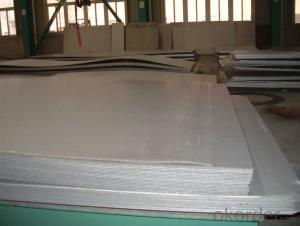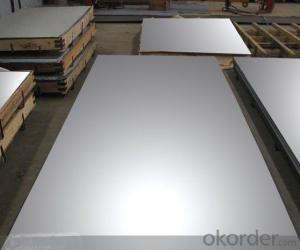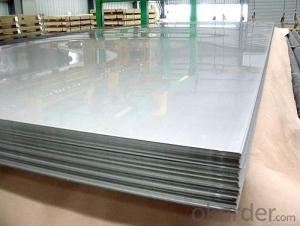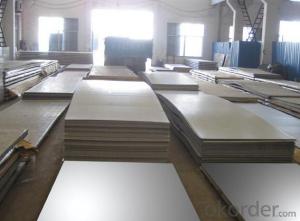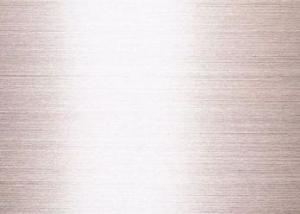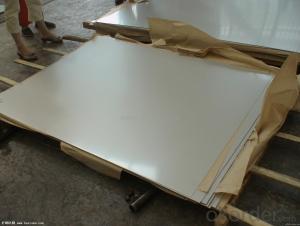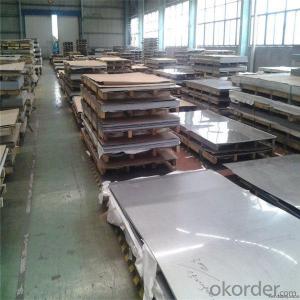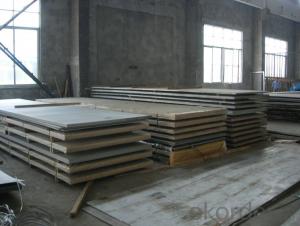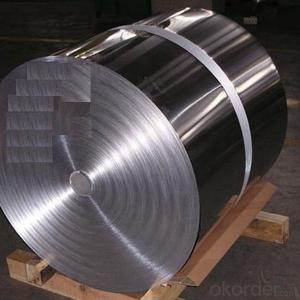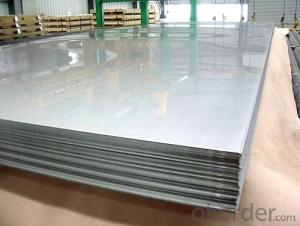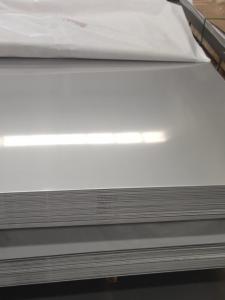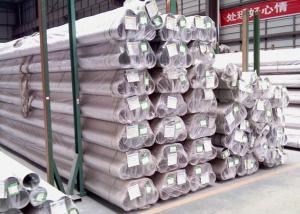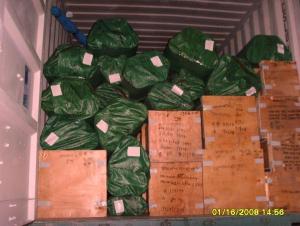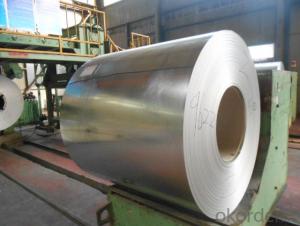Stainless Steel Sheets Steel Steel Plates 409L From China
- Loading Port:
- Shanghai
- Payment Terms:
- TT OR LC
- Min Order Qty:
- 50 m.t.
- Supply Capability:
- 20000 m.t./month
OKorder Service Pledge
OKorder Financial Service
You Might Also Like
Specification
Specifications for Stainless Steel Coils/Sheets:
Grade | C ≤ | Si ≤ | Mn ≤ | P ≤ | S ≤ | Ni ≤ | Cr ≤ |
201 | 0.12 | 0.75 | 7.00 | 0.045 | 0.045 | 1.00-1.28 | 13.70-15.70 |
202 | 0.15 | 1.00 | 2.25 | 0.045 | 0.045 | 4.07-4.17 | 14.00-16.00 |
304 | 0.08 | 0.75 | 2.00 | 0.045 | 0.03 | 8.00-11.00 | 18.00-20.00 |
304L | 0.035 | 0.75 | 2.00 | 0.045 | 0.03 | 8.00-13.00 | 18.00-20.00 |
309 | 0.15 | 0.75 | 2.00 | 0.045 | 0.03 | 12.00-15.00 | 22.00-24.00 |
310S | 0.08 | 1.50 | 2.00 | 0.045 | 0.03 | 19.00-22.00 | 24.00-26.00 |
316 | 0.08 | 1.00 | 2.00 | 0.045 | 0.03 | 10.00-14.00 | 16.00-18.00 |
316L | 0.035 | 0.75 | 2.00 | 0.045 | 0.03 | 10.00-15.00 | 16.00-18.00 |
321 | 0.04-0.10 | 0.75 | 2.00 | 0.045 | 0.03 | 9.00-13.00 | 17.00-20.00 |
405 | 0.08 | 0.75 | 1.00 | 0.045 | 0.03 | 0.06 | 11.5-13.5 |
409 | 0.089 | 1.00 | 1.00 | 0.045 | 0.05 | 0.06 | 10.50-11.75 |
410 | 0.15 | 0.75 | 1.00 | 0.045 | 0.03 | 0.06 | 11.5-13.5 |
420 | 0.16-0.25 | 1.00 | 1.00 | 0.040 | 0.03 | 0.06 | 12.00-14.00 |
430 | 0.12 | 0.75 | 1.00 | 0.045 | 0.03 | 0.06 | 16.00-18.00 |
Features of Stainless Steel Coils
(1)Good ductility
(2)Good corrosion resistance
(3)Excellent abrasion resistance and fatigue strength
(4)Good weldability
(5)Oxidation resistant performance
(6)Excellent in high temperature
Packaging & Delivery for Stainless Steel Coils/Sheets:
Packaging Detail Standard export packing or following customer's demand
Delivery Time: Within 30-40 days after deposit or according to the order quantity
Detail picture for Stainless Steel Coils/Sheets
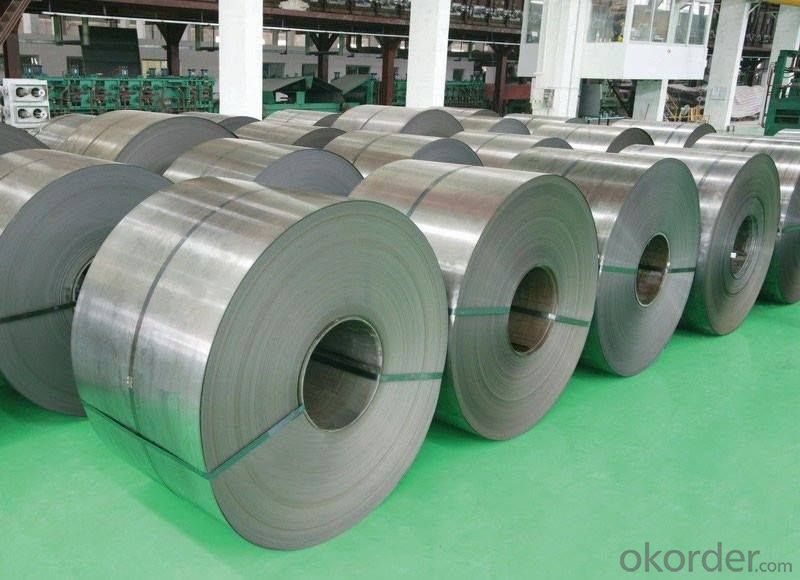
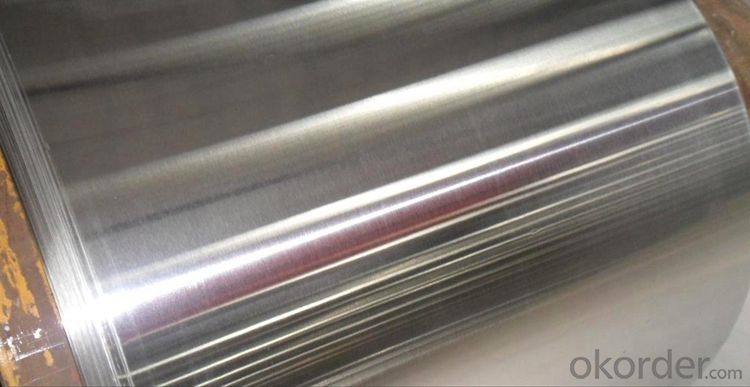
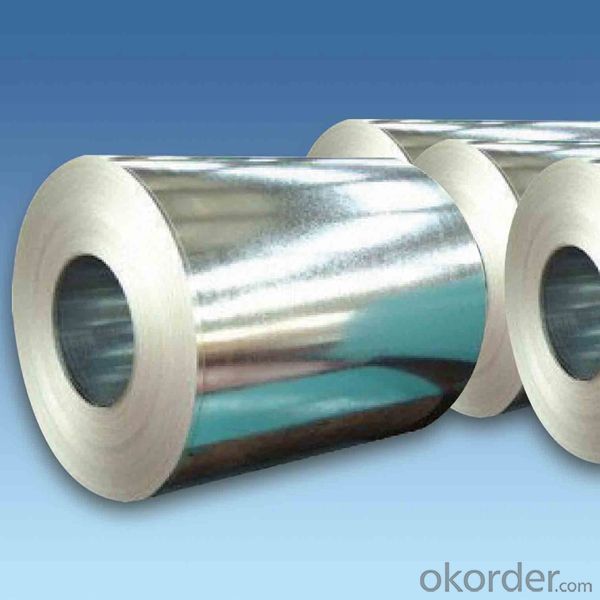
Application of Stainless Steel Coils
Finish | Definition | Application |
2B | Those finished, after cold rolling, by heat treatment, pickling or other equivalent treatment and lastly by cold rolling to given appropriate luster. | Medical equipment, Food industry, Construction material, Kitchen utensils. |
BA | Those processed with bright heat treatment after cold rolling. | Kitchen utensils, Electric equipment, Building construction. |
NO.3 | Those finished by polishing with No.100 to No.120 abrasives specified in JIS R6001. | Kitchen utensils, Building construction. |
NO.4 | Those finished by polishing with No.150 to No.180 abrasives specified in JIS R6001. | Kitchen utensils, Building construction, Medical equipment. |
NO.1 | The surface finished by heat treatment and pickling or processes corresponding there to after hot rolling. | Chemical tank, pipe. |
FAQ for Stainless Steel Coils/Sheets:
Q:How to order?
A: Please send us your purchase order by email or fax .or you can ask us to send you a proforma invoice for your order .We need to know the following information for your order.
1) Shipping information-company name, street address, phone number, fax number, destination sea port
2) Product information – Quantity, Specification (steel type, thickness, width, surface finish)
3) Delivery time required
4) Forwarder's contact details if there's any in China
- Q: Several processing techniques of colored stainless steel
- 1, water plating (mainly black, note 304 plating water plating, color instability, slightly blue, mirror surface is particularly obvious, treatment method for high temperature without fingerprint processing, but the surface will be brown)2, electroplating - PVD vacuum plasma plating (can be plated sapphire blue, black, coffee, seven color, zirconium, gold, bronze, bronze, rose, champagne, golden, light green)
- Q: Are stainless steel sheets suitable for automotive body panels?
- Yes, stainless steel sheets are suitable for automotive body panels. Stainless steel is a popular choice for automotive applications due to its excellent corrosion resistance and durability. It is highly resistant to rust and can withstand harsh weather conditions, making it ideal for use in body panels. Additionally, stainless steel sheets provide a sleek and polished appearance, enhancing the overall aesthetic appeal of the vehicle. Furthermore, stainless steel offers high strength-to-weight ratio, which allows for better fuel efficiency and improved vehicle performance. Overall, stainless steel sheets are a reliable and long-lasting option for automotive body panels.
- Q: What is the magnetic permeability of stainless steel sheets?
- The magnetic permeability of stainless steel sheets can vary depending on the specific alloy and processing conditions. Generally, stainless steel is considered to have a low magnetic permeability, making it a poor conductor of magnetic fields. However, some types of stainless steel, such as ferritic stainless steel, have a higher magnetic permeability compared to other grades like austenitic stainless steel. It is important to note that the magnetic permeability of stainless steel can also be affected by factors such as temperature and the presence of external magnetic fields. Therefore, it is best to consult specific technical data or perform magnetic permeability testing for accurate and detailed information about the magnetic properties of stainless steel sheets.
- Q: Are stainless steel sheets resistant to fire?
- Yes, stainless steel sheets are highly resistant to fire. Stainless steel is a type of metal alloy that contains a high percentage of chromium, which forms a protective layer of chromium oxide on the surface when exposed to air or moisture. This chromium oxide layer acts as a barrier, preventing oxygen from reaching the underlying metal and thus making stainless steel highly resistant to corrosion and fire. Stainless steel sheets have a melting point of around 2750°F (1510°C), which is significantly higher than the temperatures typically encountered in most fire scenarios. This means that stainless steel can withstand intense heat for a prolonged period without deforming or losing its structural integrity. Furthermore, stainless steel is non-combustible and does not contribute to the spread of flames. It does not release harmful gases or toxic fumes when exposed to fire, making it a safe material for use in various applications where fire resistance is crucial, such as in building construction, industrial equipment, and transportation. Due to these properties, stainless steel sheets are widely used in fire-rated structures, including fire doors, fire-rated walls, and fire-resistant enclosures. They provide an effective barrier against the heat and flames, helping to contain the fire and protect the surrounding areas. However, it is important to note that while stainless steel is highly resistant to fire, it can still be affected by extremely high temperatures or prolonged exposure to fire. In such cases, the material may experience some degree of distortion or damage. Therefore, it is essential to consider the specific fire rating requirements and consult with experts to ensure the appropriate selection and installation of stainless steel sheets in fire-resistant applications.
- Q: Are stainless steel sheets resistant to chemicals and acids?
- Stainless steel sheets possess resistance against chemicals and acids, thanks to the high percentage of chromium they contain. This results in the formation of a protective layer on the metal's surface, granting it exceptional resistance to corrosion and damage caused by chemicals and acids. Moreover, the inclusion of elements like nickel and molybdenum further enhances this corrosion-resistant quality. Industries like chemical processing, pharmaceuticals, food and beverage, and automotive widely employ stainless steel sheets due to their exposure to aggressive chemicals and acids. The reliability and durability of stainless steel in withstanding corrosion and chemical attack render it an ideal material for applications requiring such resistance.
- Q: What are the different types of stainless steel sheet patterns available?
- There exists a variety of stainless steel sheet patterns, each possessing its own distinct design and characteristics. Some commonly encountered patterns include: 1. Smooth or plain: This pattern serves as the most elementary and widespread option, showcasing a sleek and uncomplicated surface without any discernible texture or design. 2. Satin or brushed: By subjecting the stainless steel sheet to the gentle abrasion of a fine grit abrasive, this pattern is achieved, resulting in a uniform and directional grain. It imparts a subtle and sophisticated appearance. 3. Quilted or diamond: With a raised diamond-shaped design on its surface, this pattern enhances traction and slip resistance. It finds frequent application in flooring, stairs, and industrial settings. 4. Linen: Resembling the texture of linen fabric, this pattern is achieved by etching a series of parallel lines onto the stainless steel sheet. It adds a distinctive visual appeal and is suitable for various uses, including interior design and architectural projects. 5. Perforated: Comprising a series of small holes or perforations punched into the stainless steel sheet, this pattern creates a visually captivating and functional design. It is commonly employed in situations requiring ventilation or filtration. 6. Tread or checker: Displaying a raised checkerboard design on the surface of the stainless steel sheet, this pattern offers a non-slip surface. It is often utilized in flooring, stairs, and transportation equipment. These examples merely scratch the surface of the diverse array of stainless steel sheet patterns available. Each pattern offers a unique combination of aesthetics and functionality, enabling versatile use across a wide range of applications.
- Q: 420 stainless steel, there is no good 304
- Depends on what you used to do, 420 hardness is higher than 304, more suitable for cutting tools and so on; but 304, corrosion resistance is better than 420, if you take into account the problem of rust, 304 better.
- Q: How do you cut intricate designs in stainless steel sheets?
- Achieving intricate designs in stainless steel sheets can present a challenging task, but it can be accomplished through various methods. One commonly used technique involves the utilization of a laser cutting machine. Laser cutting provides precise and clean cuts, enabling the creation of intricate designs effortlessly. By melting or vaporizing the stainless steel with a laser beam, a smooth and precise cut is achieved. Another approach involves the usage of a CNC plasma cutter, which operates through a computer-controlled machine equipped with a plasma torch. This method ensures high precision and the capability to handle complex designs. However, additional finishing may be required for the edges to attain a polished and smooth appearance. Waterjet cutting is an alternative option for cutting intricate designs in stainless steel sheets. This method employs a high-pressure jet of water mixed with an abrasive substance to effectively cut through the metal. Waterjet cutting proves to be versatile, accommodating various thicknesses and designs, and delivering accurate and detailed outcomes. When it comes to smaller projects or fine designs, a jeweler's saw or a metal nibbler can be employed. These handheld tools enable manual cutting and offer greater control over the design. However, it is important to note that they may necessitate more time and effort in comparison to automated methods. Regardless of the chosen method, it is crucial to prioritize safety precautions by wearing protective gear and adhering to the manufacturer's instructions. Additionally, practicing on scrap pieces prior to working on the final stainless steel sheet can aid in refining the technique and achieving the desired results.
- Q: Stainless steel thermos cup 304 and 201 material what is the difference?
- 304 stainless steel corrosion resistance, high prices: 201 and 304 stainless steel material in essence difference, mainly in the elements contained in the two are not the same. 304 stainless steel corrosion resistance and stamping performance far better than 201, and the 304 stainless steel is generally used in the complex environment, need strong resistance to corrosion for 201 place, environmental requirements are not very high, or the stainless steel demand is not high place.
- Q: Are stainless steel sheets suitable for chemical reactors?
- Yes, stainless steel sheets are suitable for chemical reactors. Stainless steel is a preferred material in the chemical industry because of its excellent corrosion resistance properties. It can withstand a wide range of chemicals, including acids, alkalis, and solvents, without undergoing significant degradation or reacting with the substances being processed. Stainless steel sheets are particularly chosen for chemical reactors due to their high strength, durability, and resistance to high temperatures and pressure. They can handle the harsh conditions and aggressive substances found in chemical processes without compromising their structural integrity. Moreover, stainless steel sheets are easy to clean and maintain, making them suitable for applications where cleanliness is crucial, such as pharmaceutical and food processing industries. They also have excellent heat transfer properties, allowing for efficient temperature control within the reactor. In summary, stainless steel sheets are a reliable choice for chemical reactors due to their corrosion resistance, strength, durability, and thermal properties. They provide a safe and long-lasting solution for handling various chemicals, making them widely used in the chemical industry.
Send your message to us
Stainless Steel Sheets Steel Steel Plates 409L From China
- Loading Port:
- Shanghai
- Payment Terms:
- TT OR LC
- Min Order Qty:
- 50 m.t.
- Supply Capability:
- 20000 m.t./month
OKorder Service Pledge
OKorder Financial Service
Similar products
Hot products
Hot Searches
Related keywords
